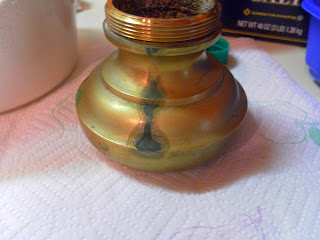Cleaning Stained Vintage Brass - A Tutorial
 |
| Hollywood Regency Floor Standing Solid Brass Candlestick Holders |
 |
| Patina is one thing, stains are another. |
The tallest candlestick stands 26 3/8 inches , the medium candlestick 21 1/2 inches and the smallest 18 inches tall without candles. These mid century solid brass Hollywood Regency style vintage candle holders were meant to be elegant and beautiful - to make a visual statement. To have a presence in a room.
Taking this into consideration, I decided to polish.
All three had staining similar to the one pictured here on the left. Who knows what from or how deep the reactive stain reached, committing to them was a risk.
I knew I could use a commercial brass cleaner and 0000 fine steel wool, available in the grocery and hardware stores. Very expensive and who wants that in their kitchen sink and going down the drain?
I found several web and blog sites recommending this or that all natural treatment. What was lacking was examples of how well the suggested treatment worked as well as before and after photographs. Several of which didn't work, or didn't work well enough to deal with the staining on my brass candle holders. I'll talk more about that later. Let me share what did work the best first and what you'll need to get started. Relax it's all natural and probably in your kitchen pantry right now!
Things You'll Need
- Spoon - I used a stainless steel spoon, a wooden spoon would work also.
- Flour - I used regular unbleached all purpose flour.
- Kosher Salt
- Vinegar 5% to 6% acidity - I used cider vinegar but you could use white vinegar.
- Bowl - I used a plastic mushroom container which I wash and keep for projects like this.
- Cotton Swab - To apply the paste directly on the stain.
- Sponge - to apply the paste for over all treatment.
- Olive Oil - to protect the metal from the air after it has been cleaned and polished.
Prep Work
If your candle holders break down into smaller pieces - take them apart one at a time and wash with warm soapy water and dry with a soft cloth or kitchen towel. This will remove any oils,dust and surface dirt allowing the mixture to reach the metal more efficiently and uniformly.
Many older pieces of brass have been lacquered. It's important to know if your piece has been lacquered you will have to use more traditional treatments to remove the lacquer prior to polishing. This treatment will not remove lacquer. For pieces which are lacquered you can use a traditional brass cleaner with 0000 fine steel wool, being careful not to rub in a circular motion or apply so much pressure as to deeply scratch the surface of the metal. Fine marks can be buffed out with a lamb's wool buffer attached to a drill.
Step One
Mix the paste. I wasn't and didn't exactly measure the ingredients and I made them in batches; treating and cleaning over a couple of days without issue. I did attempt to stay somewhat consistent and used a heaping 1/4 cup of flour, kosher salt and vinegar per batch. I doubled this when applying the overall treatment. You can adjust for too much vinegar if your paste is too thin by adding equal parts of flour and salt until the mixture is thick enough not to run.

